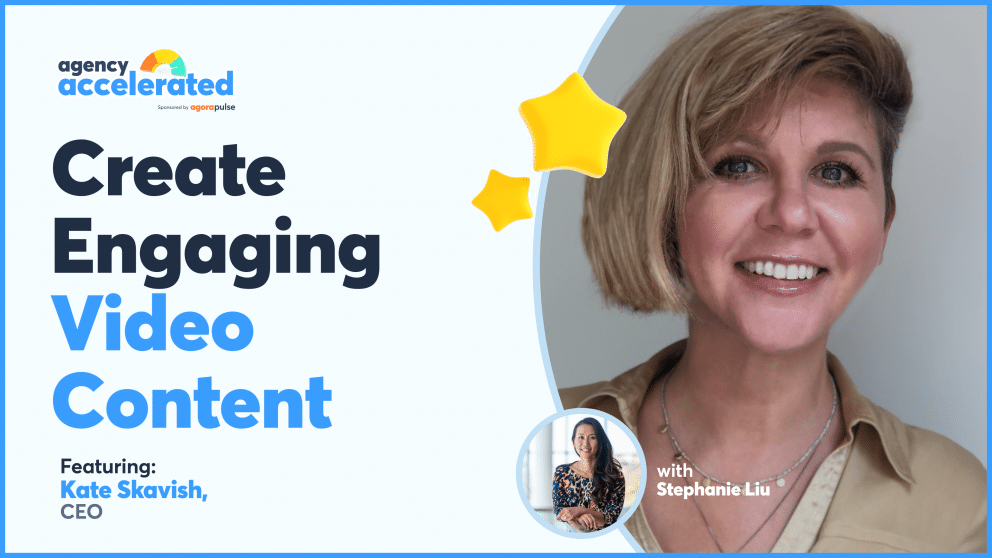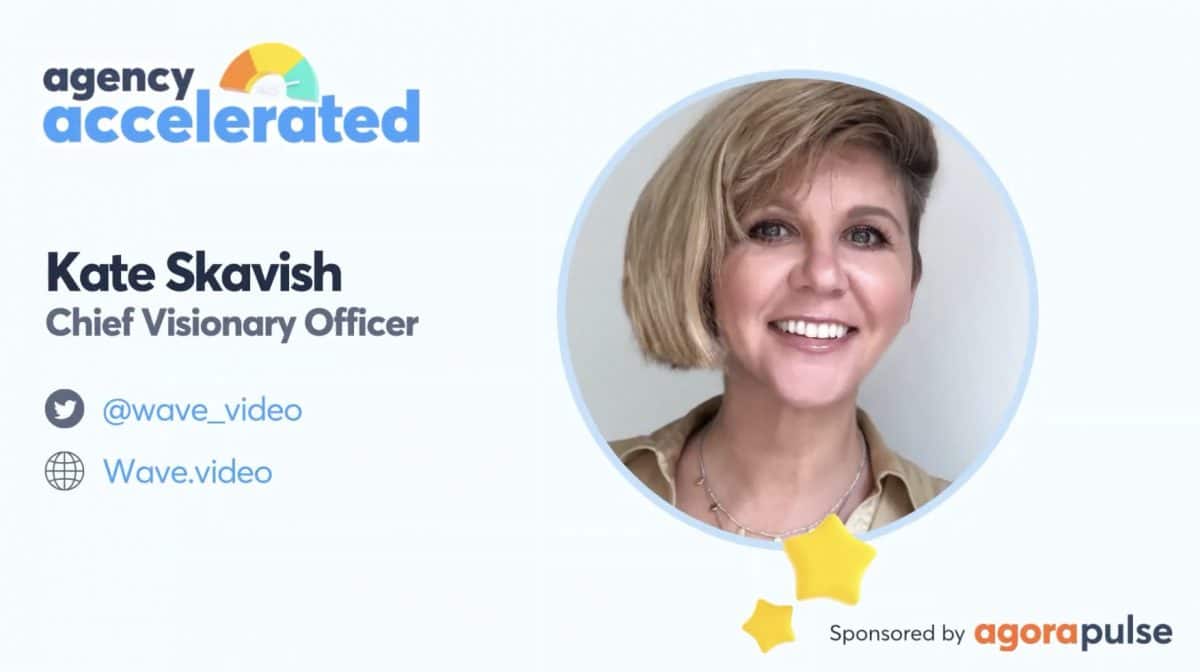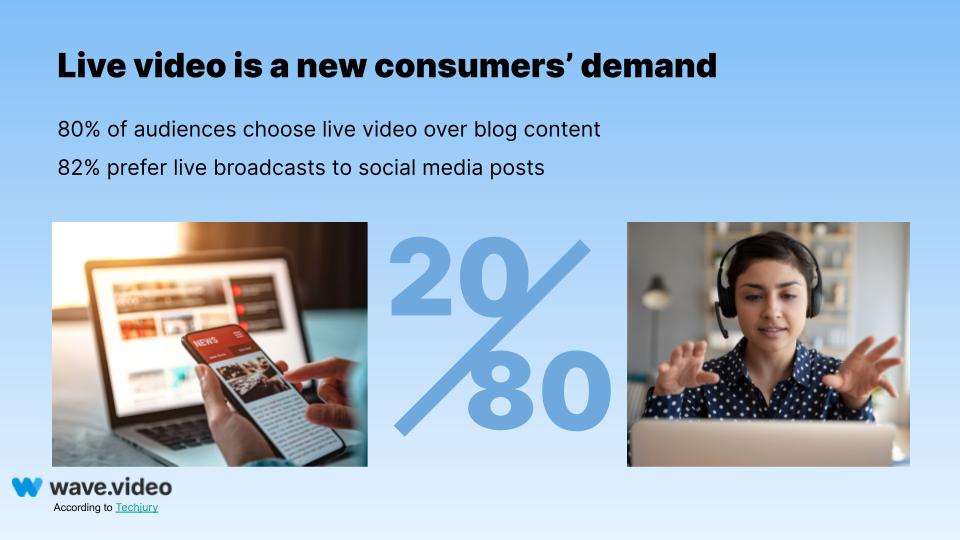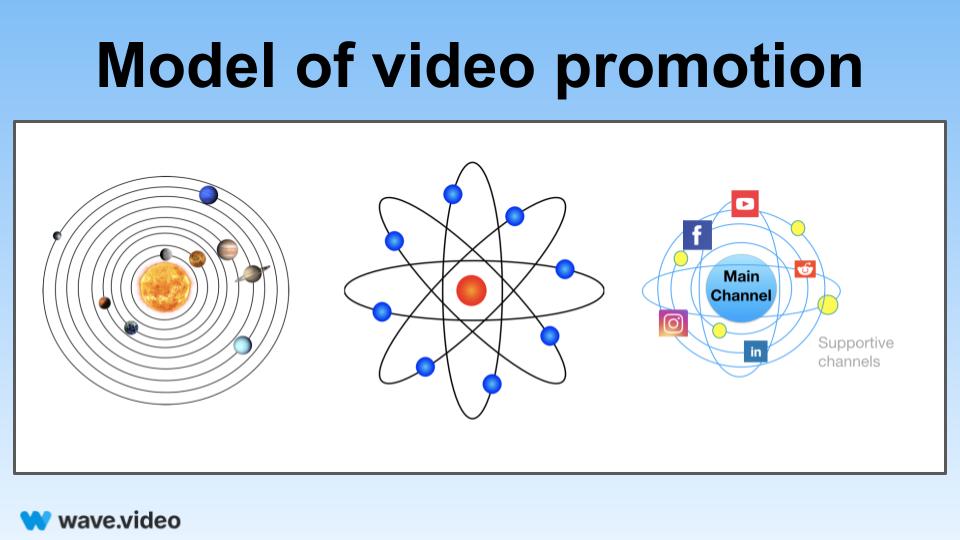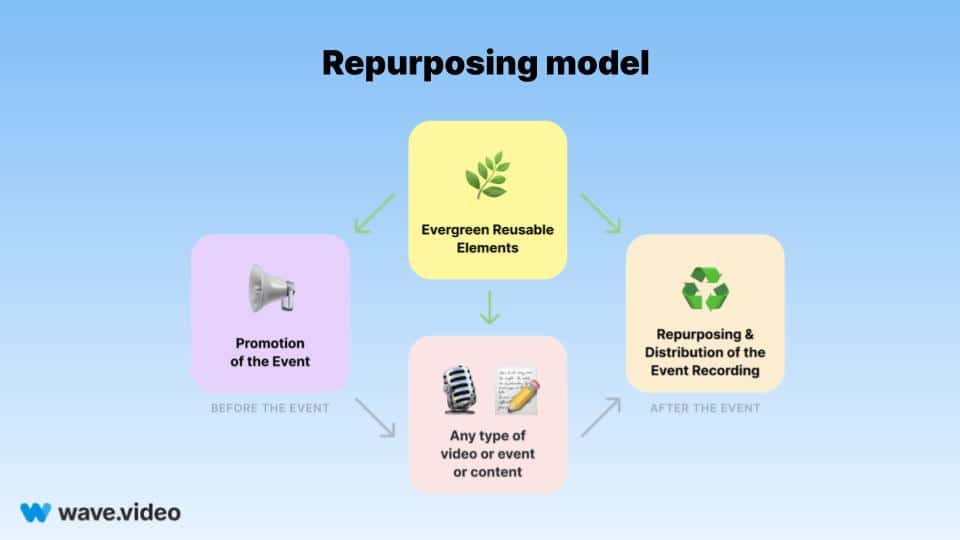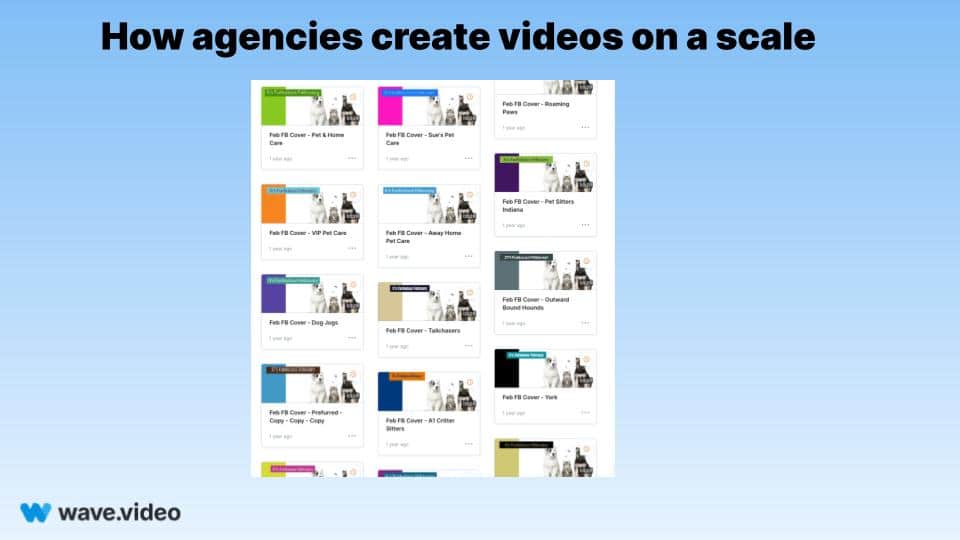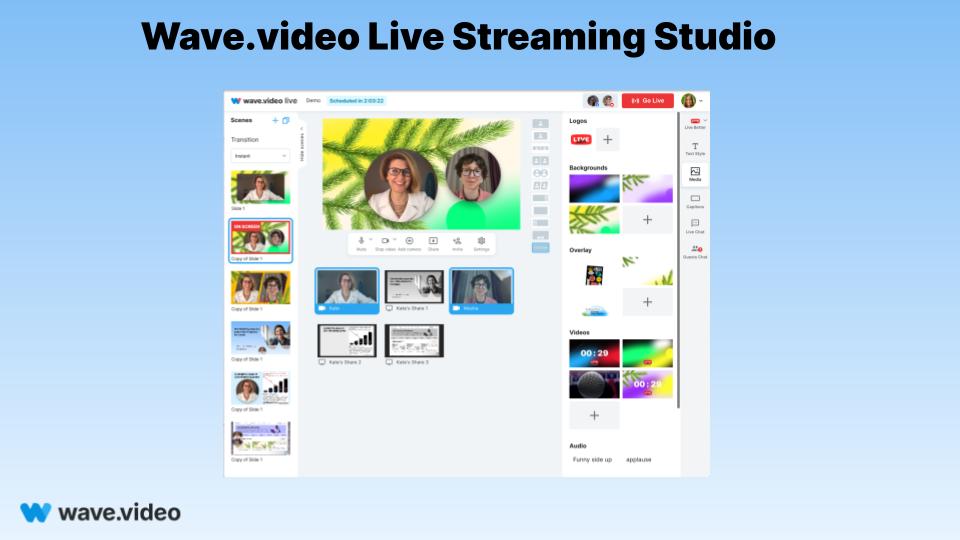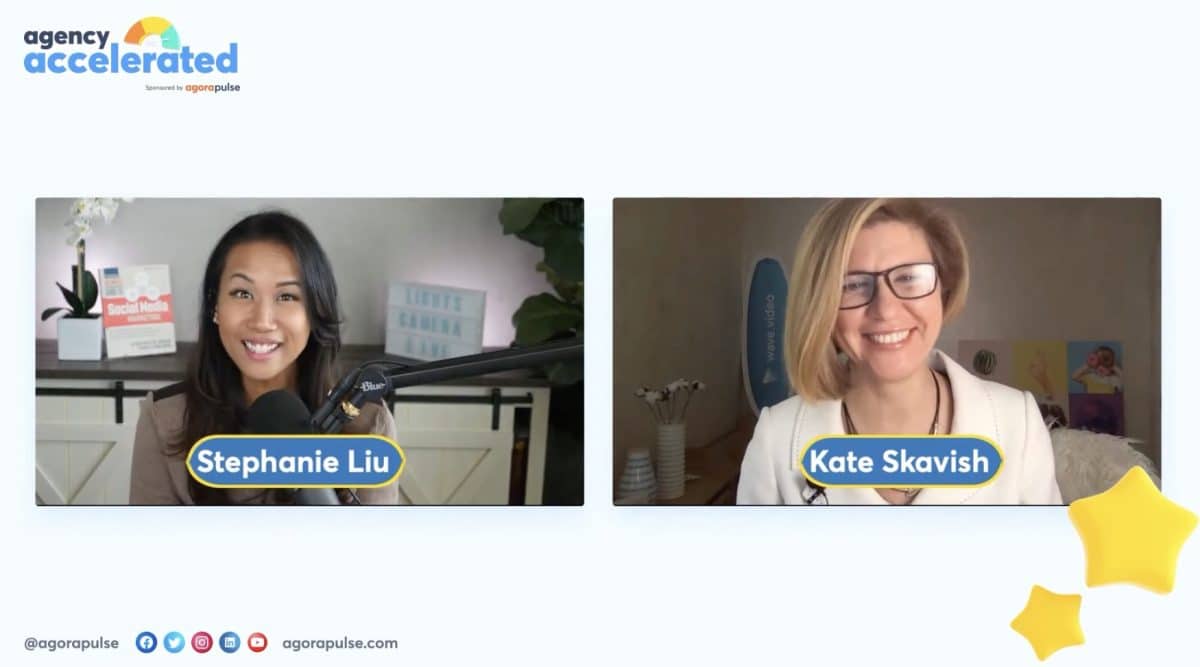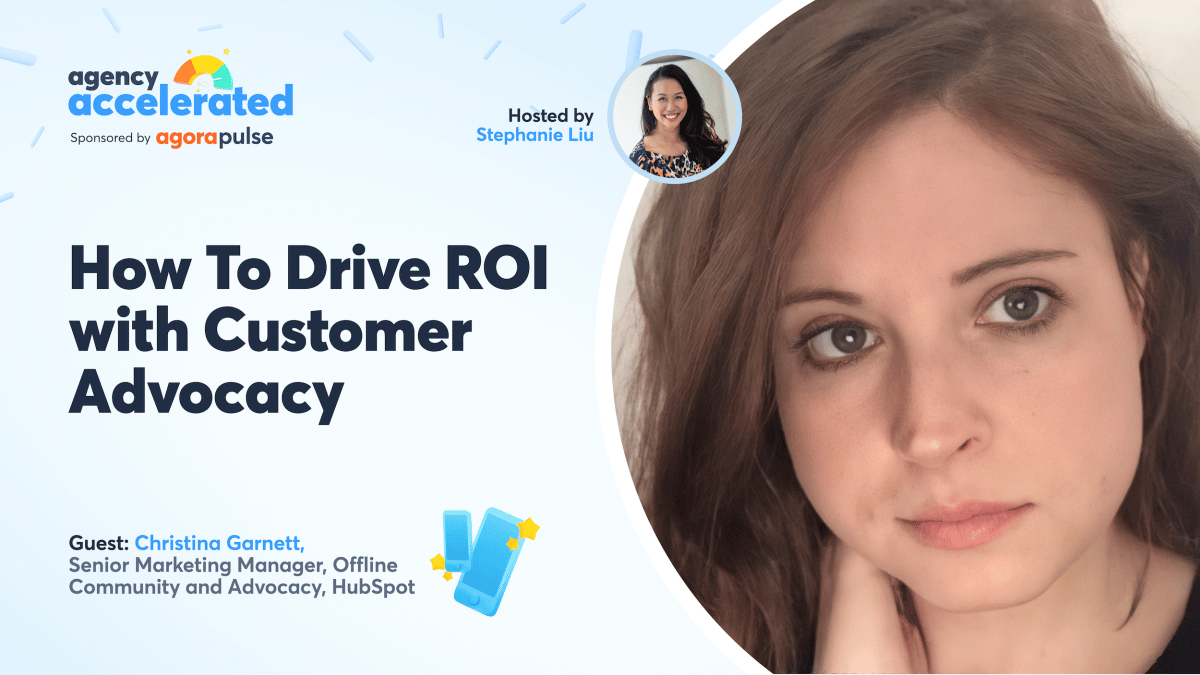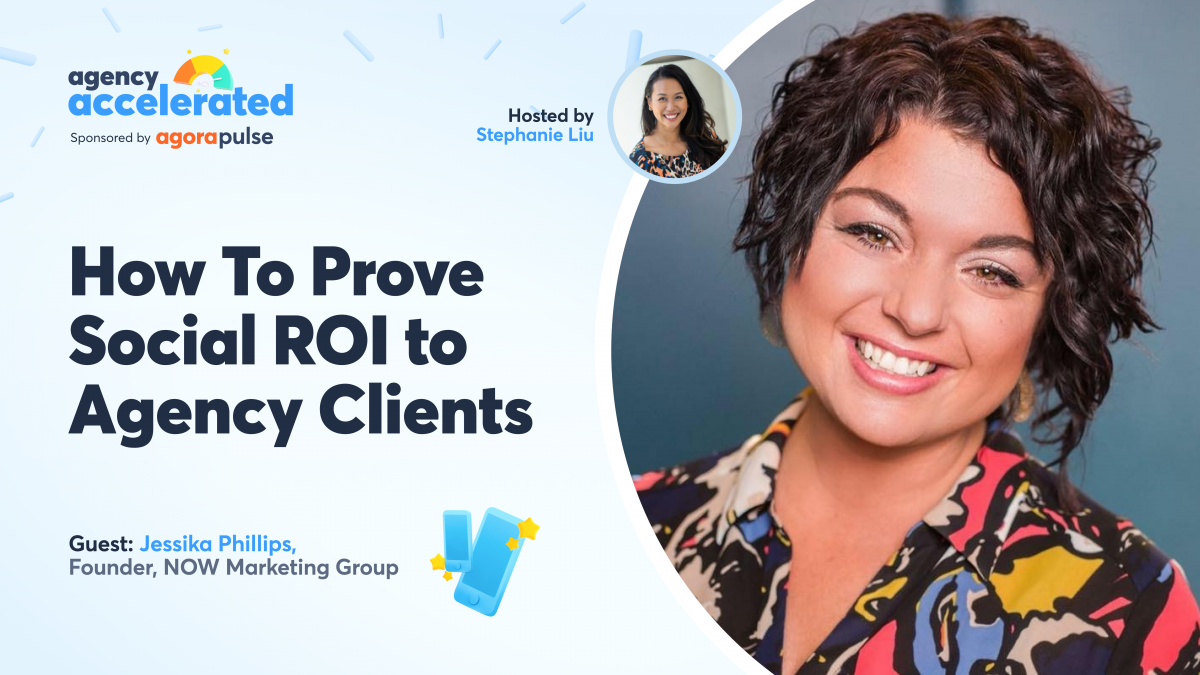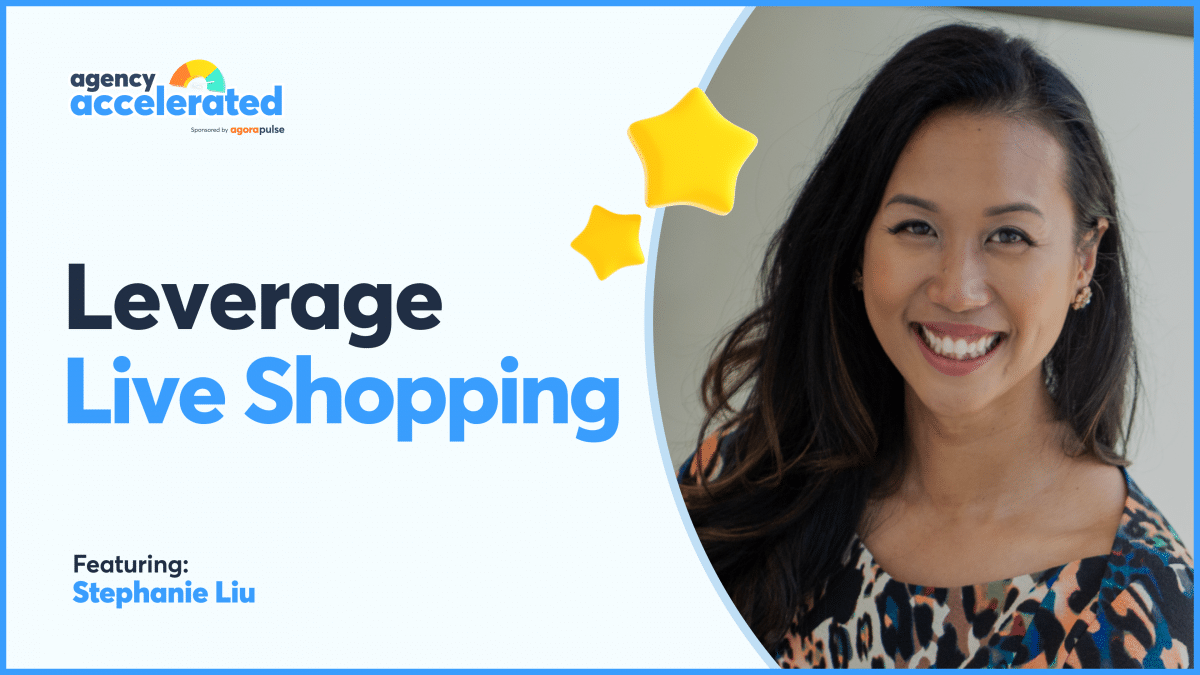Statistics show that 55% of people watch videos online every day, and social media videos generate up to 1200% more shares than text and images combined. These numbers should tell you everything you need to know about video content marketing and how important it is to scale video production.
And yet, many business owners still aren’t convinced.
And even those who are convinced lack the skills and resources they need to create video content consistently. Because the truth is, to be successful with video content marketing, businesses need to create, edit, repurpose, and distribute those videos again and again.
This means there’s tremendous opportunity here for you and your marketing agency.
That’s what we’re covering in today’s episode of Agency Accelerated.
We are live every other Wednesday at 2:00 pm ET / 11:00 am PT on Facebook, Twitter, YouTube, and LinkedIn. Make sure to subscribe to the calendar on the Agorapulse website so you don’t miss any episodes.
How many videos did you create for yourself or for your clients last month?
For host Stephanie Liu, it was at least 10… a couple Agency Accelerated live shows, six video snippets from those shows, plus a couple of other short videos.
That is one perfect example of why we run Agency Accelerated as a live video first. We’ll have a 30–60 minute video interview that we can then repurpose into many, many short videos that we sprinkle all over the internet like digital confetti.
But to accomplish that, you need a strategy and tools and processes in place, which is why we’re thrilled to have an expert in video marketing on the show with us today.
Kate Skavish is a serial entrepreneur and has a decade of experience in digital marketing and in inbound sales. She used to wear many hats and knows from personal experience the struggle of building a company from the ground up.
Kate is a co-founder and Head of Marketing at Wave.video. Wave.video is a world-class online platform for agencies and social media managers that helps scale video production, repurposing, and editing to increase ROI and stand out on social media. Holding a Master’s degree in Applied Math allows Kate to say that numbers and KPIs, in particular, are a girl’s best friend.
'There are many different ways agencies can use videos in their content strategy, but one thing is for sure: thousands of agencies use Wave.video because the platform makes their job easier.'Click To TweetWhy are videos so effective on social media?
The main idea behind why videos are effective on social media is that we love to watch videos as humans. 80% of people will choose a video over a blog, article, or another type of written content.
Additionally, social media platforms know what people like, and they want to promote content that users want to see. And what keeps people on a platform longer? Video.
For that reason, social media platforms are pushing videos more. So, we naturally like videos more, and then social media platforms elevate videos higher. This is why video content works better.
Although 80% of people prefer videos, articles, and written content is still important because that is what Google likes. But, if your article is not ranking as high as you’d like it to in Google’s search results, try adding a video. If Google sees long-form content and a video, they’ll rank it higher.
Your agency can also use Wave.video if your clients already have video content. The app’s artificial intelligence can help them create new content.
Plug in the blog URL and Wave. video’s AI will help you choose from 200 million video clips, images, and audio based on keywords from the article, to create new content you can share across the internet.
What are the key elements to a successful social media video, and what does success mean in this context?
Success is subjective and can change over time. If you are just starting out, you need to create content consistently for success.
Determining the key elements to a successful social media video may differ from one person to another, depending on where you’re at with your business. As you continue to grow your agency, gain new clients and offer new services, you may want to create videos to sell or gain brand awareness.
For example, think about brands such as Gap or Sephora, who don’t necessarily need brand awareness. Customers already know who they are. So, they have daily shows that highlight new products and measure the spikes in engagement in the video created to sell a particular product.
If your clients sell products, start thinking of ways you can use and incorporate live video into their content strategy. Additionally, think about how your agency can promote the video. Just creating the content is not enough.
'Creating content is just 20% of the work. Distributing content is 80%.'Click To TweetDetermining how many people will see your product and buy it as a result of the video depends on how you promote it. Promotional videos recorded after a live show are key to your video strategy.
Video content captures attention, has high engagement, and is a skill set that will always be in demand. Offering video content strategy and production is a fantastic service for your agency.
What kinds of videos can a business typically put out and how can an agency help scale video production?
The first step to creating video content is understanding your audience and clients.
For example, if you are a boutique agency and you work with account managers, you can create tailored content they want to see. But, you still need to show them your strategy first.
Typically clients sign with successful agencies for six months to a year and offer video as part of the content mix. To see results, you need to promote video content and any other content. You also need to sit down and create a strategy for each client to determine what will work for them.
First, with video promotion, even if you have a live event on YouTube, you still need to promote it on other social media channels. Then, push your audience to the main page, website, or wherever the sale will happen.
There are many ways agencies can organize this work for their clients. Kate notes that successful agencies have evergreen usable elements or templates. The agency creates a template for a specific brand or industry—some agencies even create 100–300 videos out of one template.
Agencies who use templates can create videos on a scale because they can quickly repurpose past content. They can also determine what videos optimize better for each platform.
Some agencies categorize their content by months. Others create branded templates and repurpose videos out of the templates repeatedly. Not only does this save time, but your clients will love having branded videos.
'Using branded templates to create video content will save your agency time and money, and maximize your return on investment.'Click To TweetNot only can your agency create templates for one client, but you can also create one template to use for different businesses.
The image above shows a template that works for every business within a niche. For example, if you work with different pet stores around the country, you can use the same templates for each client because they don’t compete with each other.
You can also organize your video content by the campaign. If your client does a lot of live shows, you can create a live show template and change the details (images, colors, copy, etc.) for each video.
Another way your agency can maximize your time and efforts when creating video templates is by hiring a virtual assistant. You, the designer, can make the templates for your clients. Then, your virtual assistant can update the templates for each live show or campaign as needed.
Your video content strategy needs to include optimizing the process of creating video. What kind of content are you making for each client? Here is an example of how you can break down the content mix:
- 20% entertainment
- 40% industry-specific
- The remaining 40% is promotional, seasonal, and direct sales
Not only does Wave.video categorize templates based on your needs, but they also offer live streaming, specifically designed for small brands who want more brand advertisements.
The live stream can be as branded as you like with different elements. You can create a show flow ahead of time and easily switch from one slide to another during the presentation.
In Wave.video, each agency can create up to 50 brands through their subscription. It’s simple to upload logos, forms, colors, and more for new brands. Once in the app, you can easily switch between brands and reuse your templates.
What kind of processes work best for marketing agencies to onboard and collaborate with clients to scale video production?
The best process for onboarding and collaborating with clients for video production is to interview the clients, determine your strategy, and set expectations. Posting three videos and getting a million views is unrealistic and won’t happen right away.
Always explain to your clients that they need to create content consistently for an extended period to see results. And throughout the journey, you’ll need to measure analytics and tweak certain elements to get them where they want to be.
As you determine strategy, ask what content mix they want to produce and how they want to distribute it. You also need to discuss timelines. Make sure your client has allowed you enough time to work on their account to see results.
Then, you can move on to the visual appearance and video elements. After you’ve created a template and your client approves it, you can decide how many templates and videos to create. The final step is to brand every type of video and create more content.
'When onboarding a new client, always set expectations, determine your video content strategy, get approval of the visual appearance, and implement each detail into new video content.'Click To TweetAlthough you can publish video content directly into Wave.video, many agencies choose to create their videos, tweak them for each individual platform, and then distribute the video content through software like Agorapulse.
RELATED: Store, Share, and Organize Social Media Assets Easily With Agorapulse’s Asset Library
Agorapulse gives you feedback on where and when to post, based on your audience. This feature can help you optimize your client’s video content for distribution and high engagement.
Wave.video offers many features that help agencies create, edit, and repurpose video content. Some of these features include:
- AI optimization
- Video editor
- Call-to-action buttons (for logos or graphics)
- Templates
- Selling products
What are some recommended distribution strategies, tools or channels for marketing agencies?
As an agency, you can create templates and produce videos, but you also need distribution strategies to succeed.
First, focus and customize videos for each platform. The content people see in their feed needs to fit the platform. For example, you can’t post the same video on YouTube and TikTok and expect the same results. Work with one platform and then change the content slightly for another.
Another recommendation is for your clients who sell products. Instead of having your client show their product to their audience, leverage influencers into your distribution strategy. It creates an additional layer of trust and social proof. It also allows you to get more creative and reach a wider audience.
Wrapping up
To learn more about Wave.video and how you can use their platform in your marketing agency to scale video production, visit their website or join their community Facebook group. You can also connect with Kate and ask her questions via LinkedIn.
Remember to subscribe to our calendar to get notified before each episode of Agency Accelerated, live every other Wednesday for the rest of 2021 at 2:00 pm ET / 11:00 am PT on Facebook, Twitter, YouTube, and LinkedIn.
If you’re looking for another way to increase and diversify your agency’s revenue streams, Agorapulse has a free webinar to help you do exactly that. Head over to bit.ly/AddAgencyRevenue to sign up for How To Add Agency Revenue By Adding Social Media Services. Get ready to learn and start driving more revenue from social media services.
Full Transcript
Expand to read the full transcript or find a section by timestamp.
[00:00:00] Stephanie Liu: Statistics show that 55% of people watch videos online every day and social media videos generate up to 1200% more shares than text and images combined. These numbers should tell you everything you need to know about video content marketing, and yet many business owners still aren’t convinced. And even those who are convinced, lack the skills and resources they need to create video content consistently.
Because the truth is to be successful with video content marketing businesses need to create, edit, repurpose and distribute those videos again and again, which means there’s tremendous opportunity here for you and your marketing agency. That’s what we’re going to cover in today’s episode of agency XL.
Welcome back to agency accelerated where we explore ways to grow and scale your agency with some of the most trusted brands and experts in the industry. I’m Stephanie Lou, and we’re live every other Wednesday at 2:00 PM. Eastern time. 11:00 AM. Pacific time on Facebook, Twitter, YouTube. LinkedIn, make sure you head on over to a Gora post-doc helm afford slash calendar and subscribe.
So you don’t miss any episodes and stay until the very end, because you’ll get a chance to get your hands on an easy way to add more revenue to your marketing agency. All right. Shout out to the crew that is here. Just definitely want to go ahead and let me know where you’re tuning in from. I’m here in beautiful sunny, Sandy Django.
And we’re going to have an amazing show today because we’re talking about video. And, you know, I love video. So question for you and the crew is let me know where you’re tuning in from. And not only that though, but here’s a question for you. How many videos did you create for yourself or for your clients within the last month?
Give me a number in the comments. How many videos did you create for yourself or for your clients within the last four months? I’ll be honest. I think for me it was probably at least. A couple of agency accelerated livestreams, six video snippets from the show, plus a couple of other short form. And that honestly, friends, that’s just one perfect example of why we run this show as a live stream first.
So that way we have 30 to 30 by like 30 to 60 minutes of video interview content that we could then repurpose into, you know, shorter videos that we could just sprinkle all over the internet. Or as I like to say, digital confetti, but to accomplish all that, you need a strategy and tools and processes in place, which is.
I’m excited to have an expert in video marketing on the show with us. So Katie’s Scottish is a serial entrepreneur and has a decade of experience in digital marketing and inbound sales. She used to wear many hats and knows from personal experience. The struggle of building a company from the ground up Kate is the co-founder and head of marketing at waved up video, a world class online platform for agencies and social media managers that helps to scale video production, repurposed.
And editing to increase ROI and stand out on social media, holding a master’s degree in applied math allows Kate to say that numbers and KPI. Are a girl’s best friend. So, Hey Kate, and welcome to the show. How are you doing?
[00:03:57] Kate Skavish: Hi guys. Thank you for the very warm in production. I’m glad to see you here. And agency accelerated.
I love this show. I love Agoda balls and I liked Stephanie very much.
[00:04:12] Stephanie Liu: Well, we like you too, and we’re really excited to have you here. Cause like I said, video marketing is one of those things that. Sometimes it feels like it’s hard to do, but when you have something like waved up video, it makes the process so seamless and easy to do.
I remember the first time that I was very, when I was first introduced to the platform, I was like, wait a second. I can get, you know, stock video already pulled in. I would just type in a keyword and boom. It was like great there. And then you also have like, these. I mean, I’m, I’m just going to say these super sexy video templates, right?
You’re like, Hey, I like that. And then I can make simple changes and then it was like done and done. You made my life as a social media strategist so much easier. And I would say that with wave.video, your customers as well, they got to love everything that you’re always paying.
[00:05:03] Kate Skavish: Thank you. It was a great testimonial.
Yeah. We have, uh, thousands of agencies using us and I need to say agencies, my favorite clients. They stay with us for years and they really, really built. On, um, you know, the process and take most out of it. And there are different ways how agency use video and our platform and how they use videos in their content strategy and overall strategy.
Of course, it’s all depends on what kind of agency it is, but I will show you quite a few ways and you can think about how you can use. And you’re exciting. Well, good, good,
[00:05:44] Stephanie Liu: good. Well, let’s, let’s go ahead and kick off. And first let’s talk about why are videos so effective on social media?
[00:05:53] Kate Skavish: Great question.
And that question can be answered on many levels. Um, main idea is that as humans. Uh, we are humans and they love to watch videos. 80% of people they’ll choose video over a blog, post article or any type of written content. So it’s our choice. We choose video. I have a slide actually. Um, if you can share a screen then yeah.
This slide and that’s one of the reasons banned. Um, the other reasons maybe, um, also important, but less obvious, uh, social media platforms, social media platforms. They know what people like, and they want to. Promote stuff that people like, because they want people like content on their platform and stay on the platform longer is they like video.
They will push video up. And that’s what happens. People naturally like videos more and then social platforms, elevate videos higher. So that’s why we just work so much better. Again. Think about your investments, 80%. The, which we do 20% voted articles, articles still very important because Google loves them.
And that’s how they show your content by reading the keyboards. But again, even your article has on it. Google show it higher. For example, I know some agencies who are on a hundred something page when you search for them, but on certain topics, Snippets of their video. They’ll go above number one, search article.
And that’s how they get a lot of stream. A lot of customers who visit their blog and that’s super effective. So not only you can use videos on social, you also can use snippets of video and, uh, your book posts or other website materials. Take advantage of videos, everything you can do in that video.
[00:08:15] Stephanie Liu: Oh yeah, absolutely.
You actually just gave like a really like ninja trick as far as, you know, if your blog article isn’t necessarily ranking in the Google searches or search results, sometimes you actually have the leverage when you put the video. On there, especially on YouTube and knowing the fact that like, Hey, maybe not a lot of people are comfortable being on camera or just, you know, using B roll and explain you that in a video that says, Hey, top 10 tips that summarizes your blog article and like, boom, all of a sudden you’re above the fold.
So that’s always helpful. Good, good, good.
[00:08:50] Kate Skavish: It sounds. And that agency also can sell to their clients. If they have already videos, they can just go to our platform. Artificial intelligence and great video out of this, uh, look post pictures from this, um, article, or maybe they can use something from our 200 million, uh, video clips and our draw and photos library.
And, um, they can exchange, but AI will create a video for them, which they can put on YouTube. And that video will go they’ll show when, you know, when somebody searched for keyboards in that.
[00:09:28] Stephanie Liu: That’s brilliant. I love how artificial intelligence, AI just keeps coming back to the show. So, I mean, all agency accelerated folks.
I mean, if that’s something that’s not on your radar, like, please, please, please, please go back and listen to that episode that we did with Ann Chang to talk about just the evolution of artificial intelligence, because it’s already here. I mean, he just mentioned that they use it over at waved up videos of that.
Always exciting. Just the fact that you could plug in the link to your blog article or even a white paper. And knowing that the AI will say, Hey, I saw that you mentioned this specific keyword, here is a video that can coincide with that and support it. So that makes it really easy. Alright. Awesome. So, can you, here’s the question for you, you know, what are the key elements to a successful social media video?
And what does success mean in that specific context?
[00:10:23] Kate Skavish: Well, that’s not an easy question because success is always. Some, some people set for themselves or organizations set for themselves and it moves, um, in time, if you’re just starting on social success for you, you’ll be creating content consistently.
Right. But then in a year or half a year, and same for your clients, there might be different goals. You want to use your video to sell, or you might want to use your video for. Linda’s generation purposes or brand generation brand awareness. That really depends on where you are in your journey, um, on social media.
And if you think about brands who doesn’t need Brenda, Like gap or a Sephora, they have daily shows, whereas the show new products, and then they measures the spikes that video show created in the cell of this particular product. So if you, your clients sell some products, think about using live video and in it.
And when you use live video, think about promoting it because just creating content is 20%. Work and 80% is distribution. So how many guests will become into your show or how many people will see your product and buy as a result, right? It all depends on your promotion and promotion, the promotional videos.
And we just. Recorded content after life shows. That’s key. It’s very important. And it should be a part of video strategy for you or your clients, which is very convenient, right? Use enough gland, for example, in the cell phone products online, and then you need to promote show before or event or, uh, promote, uh, the results of it.
So there is more video work.
[00:12:25] Stephanie Liu: There’s always work in video. There’s all the different things that you can do. I mean, especially from live streaming, right. You know, you have the promotional videos, then you actually have the production in and of itself. And the repurposing, all of that. Yeah, all that is it’s exciting.
And it’s one of those things where I tell people, you know, when you get started in video, it’s one of those skillsets that will always be in demand, just because of the fact that it captures so much attention, so much engagement. And I love even how you mentioned how live streaming and live shopping, you know, it should all be incorporated in your overarching video content strategy.
So then having said that, K, what kinds of videos can a business typically put out there and how can an agency develop a steady stream of source codes?
[00:13:13] Kate Skavish: Very good question, Stephanie. So, uh, there are, of course all sorts of, um, videos that you can create and you need to understand your audience and what kind of clients you’ve got.
Um, if you boutique agency and you work with like clients and you have account managers and you can tailor content for this particular clients. Client you have. That’s great, but still you need to show them strategy first because successful clients, successful agencies, they sign their clients for six months for a year and they offer them.
Videos as a part of constant mix and to see the results, you also get promoted, video content and any other content you have. Uh, if you sell online, you need to promote your librarians. So there is a lot of work and you need to sit down and figure out how the work for your agency. Actually, if we share a screen, I have an examples.
Um, first of all, video promotion, if you have live with. Let’s say on YouTube or on other platform, you still need promoted all over social channels and push everyone to this main page or website or whatever where the sales happen. And then you need to do it for your clients if you have many, right. And there are different ways how agencies organized work in this class.
So, again, this is about a repair person model. So what we pitch to our clients and what I see successful agencies, do they have evergreen usable elements, which means templates. So they create template either for specific brand or for a specific industry. I’ve seen some accounts where, uh, out of one simple.
Hundreds video hundreds, like 300 videos created. For example, I know some people who are their niche is like pet industry or pizza. And yeah, and think about it when there are 300 of those. Let me show, I actually have a slide. So let me, um, go ahead. And that’s what I hear. I’m talking about, like, um, repurpose and videos and, uh, place in video, um, optimized for each platform because video should work better than the optimized.
Right. But then I want to show something that. And you can do it in our product, what actual agencies, uh, done. So first of all, some of them have, um, content or clients, uh, categorized by, um, months. Uh, some of them, uh, create brand template. And then clearly just out of that template repeatedly that, um, saves a lot of time because they know that our clients love that sort of video and that sort of branding.
So. Um, just, um, verify it once and then go visit style later on without extra communication. It saves a lot of time and money, uh, for agencies and maximize return on investment. Uh, here’s another example of the same idea. Here’s different approach, a lot of similar businesses, different locations. They don’t compete with each other because they’re in different states.
Um, agency just create this template, which works for every business of that niche, right. Uh, pet store, uh, for example, and boom, once a month, they create new template. Uh, or like tempting plates. And, um, I would have this template 300 videos, so very efficient. They can charge less and still have a lot of return, a lot of margin left after they do it because they just have so many clients in this niche, this agency well known for this, that particular niche and more clients go there.
So it’s like a circle, you know, it works, they will known and it brings. Um, results. Hmm. Sometimes you need to organize, but by campaign your content by campaign, and here’s a few shirts it’s from our life show. So everything related to this live show goes into one folder that right in plates, and we just change colors, uh, for this.
And, uh, that’s super easy, right? We don’t have to think about concept of this video is just very technical. Uh, we can usually our designer create a template and then everyone on the team can do it. Can change this template, uh, place another picture and it’s super efficient. Same. And we learn it from our agencies actually, how they do it.
Right? So agencies creates this process where first somebody from my team creating plates for this client approve it. And then it’s virtual assistant cook who can create next videos because everything is said and CLA clients. So this idea of optimizing the process of creating video is very important and.
I’ve seen agencies as successful when they really know how to, you know, nail this process and how it will set regionally, uh, expectations of the clients. Right? So, um, if they create video content, what kind of content, what kind of content mix it will be? For example, 20% will be entertainment. Industry specific 40% will be promotional, some seasonal stuff.
Um, Maybe some direct sales or some ideas. So there is always Meeks and the protons of that type of another type, uh, can be discussed with clients. What we have, uh, on baby video, we have, uh, I dunno if, if you can see my screen because it’s an indifferent. Okay, you can’t, uh, we have in place on our website and templates are categorized.
And sometimes like if you click on apps and promo section, everything that could be in your content mix and everything that you can offer to your clients is there because we talk to so many agencies. Interview them. We ask what kind of contents they offer and they explained us everything. Now we know.
Yeah. And, uh, easily, uh, can guide our clients. So here we are. Oh, well, yeah. And other thing, uh, I don’t know if I should mention it now or maybe we should go to the next question, but yeah, that’s another option that we’ve done. Video will provide. We have a streaming platform, which, uh, designed for small brands.
Who want more brand advertisement with the livestream and this livestream could be branded very heavily or not heavily as you want, and every element of branding. So let me show how it could look like, uh, you can, um, have a show floor plan ahead of time and you just switch from one, uh, Slide to another one presentation to another.
Uh, we just had this earlier today with our designer and I took a few screenshots and she took screenshots and now we have, um, Now I show them. So here, uh, she shows like, um, seasonal overlays for livestreaming, and I think there’s a, um, cool. And I can’t wait to use more of them. And another thing which helps our, I don’t think it’s on my.
Presentation, so we can stop sharing the screen. Um, the other thing, which is super helpful and we created, uh, because of the engines, the demand is Brendan. Each agency can create up to 50 brands with their subscription. And, um, yeah. When, when your edits in place, you just switch between. And in new brands, you have like their logo related photos.
So you upload forms, colors, they usable, uh, type of, um, Brenda Brent pieces in the system. And then you just reuse them in it’s super efficient and fast. So once you sit as a brand and your manager will say like, it’s okay, client approved, you can go and really streamline video production.
[00:22:17] Stephanie Liu: Yeah. You could hit the ground running.
So, so for those of you that are just tuning in, we’re talking about how marketing agencies can help their clients with video content at scale. Well, what I want to like backtrack just a little bit, because she just dropped a bomb. And I don’t know if you guys actually caught this, but like waved off video is going to be launching a new live streaming capability.
Which for me, I was like, oh my God, put me on a screen. That’s crazy because you know, I’ve, I’ve tested and I’ve played around with various live streaming studios and platforms that are web based and to see like, hello wave video has entered the arena. That’s, that’s pretty exciting just to see that because.
The question that I had asked you is like, Hey, how can agencies, you know, incorporate video content production into their whole wheelhouse to generate more profits. And you had talked a lot about like the different templates using the agency version, where you could just turn out different videos. For clients in different cities, states, and all those different things.
Even the one that you were sharing about the pet industry, I was like, oh wow. That is that’s super freaking clever. And then you, and then you were just like, oh yeah, PS, by the way, there’s a latch to meet things. I mean, you guys, this is pretty exciting as far as what we thought video has in store. I’m really curious to see how that looks on the back end.
But first a quick story about how one growing company has scaled their social media overall. So let’s go ahead and check this out real quick.
[00:23:51] Kate Skavish: Fracture is a company out of Gainesville, Florida founded on the belief that the printed image has a lot of power. We wanted to make it as absolutely simple as possible for people to take photos.
From being buried in their camera, roll on their phones to being something they can celebrate on the walls. Originally, we essentially were doing a lot of manual social media management. Um, and then as the company grew, we started to try different platforms for social media management and marketing. Most of the ones that we used, we were somewhat satisfied with, but never found something that really addressed everything that we.
We use the Gorbals for our social media marketing. It’s really fantastic because it allows us to connect to the marketing side of what we do with our customer support. We now use the Gorbals to easily assign a support request. As soon as it comes in Agorapulse has really allowed our company to expand and upgrade our social media management abilities.
I think that, uh, smart marketers nowadays are constantly on. Um, for new companies like , who are able to deliver the same kind of results and I’ll be in a way that ends up.
[00:25:15] Stephanie Liu: Now, if you’d like to learn more about how Agorapulse helps thousands of agencies grow and scale their business, head over to bit leap forward slash ad agency revenue for a free webinar. Now, having said that let’s get back to learning how to scale video production and content for social, because we all know that it’s here to stay. And if you don’t already have someone on your team, Focused on creating a video for social media.
That’s definitely something that you want to pay attention to. So Kate, when we talk about producing videos for clients, in your experience with your clientele, the customers that are logging into wave.video, what kind of processes work best for marketing agencies to onboard and collaborate with clients?
[00:26:04] Kate Skavish: Well, the best process of course, to interview the clients and set strategy. First sets the expectations first, because if a client came to you and they want to post three videos and get a million views. Just not going to happen. Right. And you need to explain, and you need to have this explanation regime.
When they come to gym three times a year, they don’t expect to be athletic. Right. And they don’t expect tools. V3. That’s normal. Maybe if they do expect that they need to change their expectations. And that’s what the conversation is about. They need to understand that they need to do something consistently for a long period of time to start seeing.
And they’re using it to measure stuff and tweak it a little bit, but what, you can start with them to set up the strategy, what kind of content content mix they will be getting, uh, what would be your help in creation content in the distribution of content? Because the most work goes into distribution, right?
And, uh, then you need to talk about timepiece. And make sure that clients allowed enough time for you to work with his account, to see the results. Right. So that’s given and then important part is to kind of have everybody agree on video elements, strategy. The visual part of it, as soon as the client approves template, you grade, right?
You can do one or three templates or depends, uh, how many templates you agreed, what kind of videos you want. And then you can just go and brand and different type of videos that you agree on and create more content out of it. So every sense should be set head of time, especially expectations, right?
Expectation. Strategy and then implementation and approval of, um, visual patterns. I
[00:28:05] Stephanie Liu: agree. Yeah. Having a strategy in place, as far as how often we’re going to create content, what type of content we’re going to create, knowing which platforms it’s going to live on as well as setting expectations. And not only that though, but turnaround time.
Right? Because once you develop a video and you get feedback, you definitely want to incorporate the feedback. Edit as needed. And once you have it all templatize and from there, it’s really just the distribution piece of it. And remind me with wave.video. Um, you could publish directly into the platform, right to the,
[00:28:40] Kate Skavish: but that’s not what most of our clients do.
They create one type of video, then they, um, slightly tweak them for each platform specifically. And then distribute through software. Like I go to pals, which you just mentioned, our team uses it. And trust me, we use a bunch of other, uh, software. We have different, um, account managers and social media managers come into our, uh, team and they can visit different background, but in that fusion, But they have a choice, right?
They’ve chosen, I’ve got a pals because that’s what you want to do. You want to, um, post, um, all the content in the optimized timing to know when, um, clients. Is on, I don’t know, Facebook, Instagram, YouTube, whatever, where you post and do it exactly at that time. And Agorapulse also gives you this feedback where you want to post it and you listen to this feedback and you optimize it.
So it’s like a work in progress and you need some time to load.
[00:29:53] Stephanie Liu: Absolutely. So let’s, let’s go back to wave.video. Cause what are some other features that we’ve up video has to help agencies create, edit and repurpose their video content?
[00:30:07] Kate Skavish: Um, well, as I mentioned, we have, uh, AI, we have, uh, one of the best, I believe, of course, best, uh, video. And we make it super easy for agencies or any marketers create and brand videos in, in the product.
Um, Of course, uh, most of the videos have call to action in the end where you can place your logo or any graphics you like, um, on your video. But then, uh, think about strategy that you just, we just talked about discussing strategy because the clients, for instance, your client has actual products that they want to sell.
Right? The best way, of course, always to sell life because. People like this unfiltered content, you’re looking at my presentation life, you know, everything that I said, it’s just, um, you know, you receive it on the same, but I can ask you questions, what you like, what you would like to learn more about. And there is some, um, conversation going on when you show your product life, um, when cannot be happen in any other place.
And, uh, there was a pandemic it’s like, clearly. As close as it gets through your life. When you come online and show your product online, and if your agency who helped your client to sell real products, then you have to teach this life strategy and you have to teach a promotion of life events as well, because that’s super important.
And sometimes you need to pitch the whole strategy, that idea, or. Promotion before the radiant event itself, then report person and placing materials all around, uh, all social media platform that clients can find off, uh, can think of. And Glens of Glen’s can be because you cannot, uh, tell your audience where to be, right.
They are where they are. You just can come to their, you know, present place and offer themselves.
[00:32:18] Stephanie Liu: That’s true. That’s right now agency accelerated friends. We’re getting close to wrapping things up with Kate. So if you’ve got questions, now’s the time Kate, I’ve got one more question of my own. I think you’re definitely gonna blow my mind about this and give me some good things to think about.
But first I want to give a quick shout out to the crew. We’ve got Chad Peterson in the comments. Thank you so much for tuning in friend and congratulations on the new show. So wonderful to have you here and shout out to the crew that has said that, you know, when it comes to creating their content, it’s super duper helpful.
In fact, I’m trying to find that one. Chad is saying your guests can bring in their branded pieces from their own way of account too. So it makes it a lot easier. As far as integrating your content. We have a couple of your viewers as well that says that they love wave.video. Yeah. I remember the, I think it was like social media microbiome maybe two years ago or so time has passed by, but I mean, you had this wonderful booth as far as like showing how social media marketers can really just take advantage of wave dot.
So having said that, Kate, uh, what are your recommend, what are your recommended distribution strategies or tools or channels for marketing agencies to scale video production? Because if we’re creating all these templates and we’re producing these videos, what are some of your distribution strategies and tips that we could go ahead and, you know, jot down in our agency notebook.
[00:33:53] Kate Skavish: Oh, well, it’s all the same. Try to focus and a customized video for each platform. So the type of content people see in their feed fits to their platform. You cannot, uh, pose the same stuff you put on Tik TOK. You can put it on, uh, YouTube and expect the same results, right? It’s just not gonna work. You need to remember about that.
So this specific and, uh, mm. The specific to a platform and then you distribute the content. So this is pure person idea and changing content slightly. So it will, you’ll be working better on particular platform is important. Again, if you show some products, uh, or your clients show some products, maybe it’s the best.
If somebody else not, the company itself shows us product, that sort of stuff always work better because it creates additional trust. Month, like somebody from the company and get paid to say
[00:34:51] Stephanie Liu: this well, like an influencer. Yeah. I think leveraging influencers or at least incorporating influencers into your distribution strategy is absolutely ideal because more often than not, when we’re looking at our own analytics, we know what works on our channels and when we’re able to provide assets and let our own influencers get creative.
You know, they, it gives us an opportunity to reach a wider audience because you never know, like sometimes as marketers, we think like, oh, you know, th the, the standard platforms, Facebook, Instagram, LinkedIn, Twitter, and YouTube. And then I’ll talk to like one of my good friends, Shelly saves the day and she’d be like YouTube shorts.
Like, I didn’t even think about that. Or I’ll have like my good friend Kayla over at e-comm or he’s talking about Tik TOK ads. I was like, oh, now that’s interesting. I’m fine. Fine. We’ll keep, this has been an extremely educational and fun interview. Thank you so much. And like the fact that you slipped in the live streaming stuff do cracks me up because I’m like, wait a second.
That is that’s exciting. So Kate, can you tell our folks where it’s the best place to find you and to learn more about using Wave to scale video production?
[00:36:07] Kate Skavish: Uh, of course online with wave dot video, that’s the website. They also have a very active and great Facebook community community, um, with a video community, very simple to remember, and a welcome there.
Uh, joins this group. It’s free to join. Uh, you can find me on LinkedIn. I think it’s the best way to contact me. I check it often. And again, you can find me in the community. I often speak there and I answer some questions and yeah.
[00:36:40] Stephanie Liu: I love it. Your LinkedIn is probably like one of my favorite platforms as well, because I know that when people reach out to me on LinkedIn it’s business related, I mean more often than not it’s business related, I don’t really get spammy messages.
So I love that. That’s the best place to reach you as well. All right, friend, that’s all that we have today, but don’t worry. We have even more incredible shows. After the holidays. In our next episode, we’ll be talking to the agency, coach Chris Rudolph. Who’s going to teach us how to accelerate the growth of our agencies.
In fact, Chris, we’ll kick off season three, OMG, season three, and we’ll be joined by Patty Miguel from UNR. You guys absolutely know that. I love Patty Miguel and Rory Sutherland from. Kevin Lau from Adobe. We also have David Fisher and our very own Teresa Anderson head of agency business at a Gora pulse.
So if you haven’t done so already, remember to subscribe to the calendar at agorapulse.com/calendar, if you want to be sure to catch our live episodes. And if you enjoy. Listening. Just as much as I do remember that agency accelerated is available on your favorite podcast channel. So subscribe, leave a review, let us know what you think.
And if there’s anyone else that you’d like to have on the show in our lineup, go ahead and read. Last, but not least take advantage of our free webinar on how to add agency revenue by adding social media services, head on over to bit Lee Ford slash ad agency revenue, and I’ll see you and your agency accelerating into the next show.
